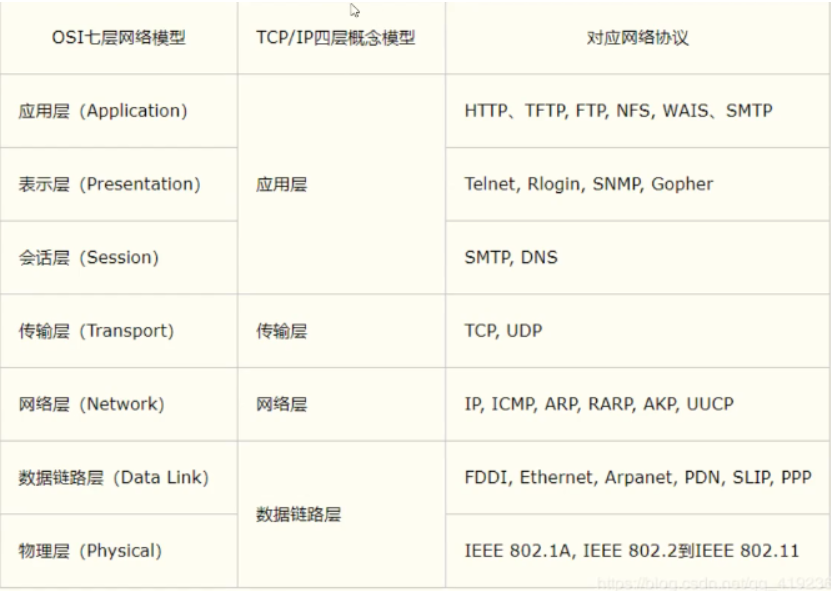Java网络编程
1.1概述
1.2 网络通信的要素
如何实现网络的通信
通信双方的地址:
-
ip
-
规则:网络通信的协议
TCP/IP参考模型

小结:
-
网络编程中有两个主要的问题
-
如何准确的定位到网络的一台或多台主机
-
找到主机后如何进行通信
-
-
网络编程中的要素
-
IP和端口号
-
网络通信协议,TCP,UDP
-
-
万物皆对象
1.3IP
ip地址:InetAddress
-
唯一定位一台网络上的计算机
-
本机localhost
-
IP地址的分类
-
IP地址IPV4/IPV6
-
IPV4 3 2位 4 个字节 0~255 例如:127.0.0.1
-
IPV6 128位 16个字节
-
-
公网(互联网)-私网(局域网)
-
ABCD类地址
-
192.168.?.? 专门给组织内部使用的
-
-
-
域名,是为了更好的记忆
//查询本机地址
InetAddress inetAddress1 = InetAddress.getByName("127.0.0.1");
System.out.println("inetAddress1 = " + inetAddress1);
System.out.println("---------------------");
InetAddress inetAddress2 = InetAddress.getByName("localhost");
System.out.println("inetAddress2 = " + inetAddress2);
System.out.println("---------------------");
InetAddress inetAddress3 = InetAddress.getLocalHost();
System.out.println("inetAddress3 = " + inetAddress3);
System.out.println("----------------------");
//查询网站ip地址
InetAddress inetAddress4 = InetAddress.getByName("www.baidu.com");
System.out.println("inetAddress4 = " + inetAddress4);
System.out.println("----------------------");
//常用方法
System.out.println(inetAddress4.getAddress());
System.out.println(inetAddress4.getCanonicalHostName()); //获得规范的名字
System.out.println(inetAddress4.getHostAddress()); //获得ip
System.out.println(inetAddress4.getHostName()); //域名,或者自己本机的名字
1.4端口
端口表示计算机上的一个程序的进程:
-
不同的进程有不同的端口号,用来区分软件
-
被规定0~65535
-
TCP,UDP 65535*2 单个协议下,端口号不能冲突
-
端口分类
-
公有端口 0~1023
-
HTTP:80
-
HTTPS:443
-
FTP:21
-
Telent:23
-
-
程序注册端口:1024~49151,分配用户或者程序
-
Tomcat:8080
-
MySQL:3306
-
Oracle:1521
-
-
动态,私有:49152~65535
常用cmd语句
netstat -ano #查看所有的端口
netstat -ano|findstr "**" #查看指定(**)的端口
tasklist|findstr "**" #查看指定(**)的端口进程
-
InetSocketAddress socketAddress = new InetSocketAddress("127.0.0.1", 8080);
System.out.println("socketAddress = " + socketAddress);
InetSocketAddress socketAddress2 = new InetSocketAddress("localhost", 8080);
System.out.println("socketAddress2 = " + socketAddress2);
System.out.println(socketAddress.getAddress());
System.out.println(socketAddress.getHostName());
System.out.println(socketAddress.getPort());
1.5通信协议
协议:约定
网络通信协议:速率,传输码率,代码结构,传输控制
问题:非常的复杂
TCP/IP协议族
重要:
-
TCP:用户传输协议
-
UDP:用户数据报协议
TCP UDP的对比
TCP:
-
连接稳定
-
三次握手,四次挥手
-
客户端,服务端
-
传输完成,释放连接,效率低
UDP:
-
无连接,不稳定
-
客户端,服务端:没有明确的界限
-
不管你有没有准备好,都可以发给你
-
DDOS:饱和攻击
1.6 TCP
客户端
-
连接服务器Socket
-
发送消息
public static void main(String[] args) {
Socket socket=null;
OutputStream os=null;
try {
//1.要知道服务器的地址
InetAddress serverIP = InetAddress.getByName("127.0.0.1");
//2. 端口号
int port=9999;
//3. 创建一个socket连接
socket=new Socket(serverIP,port);
//4.发送消息
os = socket.getOutputStream();
os.write("hello".getBytes());
} catch (Exception e) {
e.printStackTrace();
}
finally {
if(os!=null){
try {
os.close();
} catch (IOException e) {
e.printStackTrace();
}
}
if(socket!=null){
try {
socket.close();
} catch (IOException e) {
e.printStackTrace();
}
}
}
}
服务器
-
建立服务的端口ServerSocket
-
等待用户的连接accept()
-
接受用户的消息
public static void main(String[] args) {
ServerSocket serverSocket=null;
Socket accept=null;
InputStream inputStream=null;
ByteArrayOutputStream byteArrayOutputStream=null;
try {
//1.我先得有一个地址
serverSocket = new ServerSocket(9999);
while(true){
//2. 等待客户端连接
accept = serverSocket.accept();
//3. 读取客户端的消息
inputStream = accept.getInputStream();
//管道流
byteArrayOutputStream = new ByteArrayOutputStream();
byte[] buffer = new byte[1024];
int len;
while((len=inputStream.read(buffer))!=-1)
{
byteArrayOutputStream.write(buffer,0,len);
}
System.out.println(byteArrayOutputStream.toString());
}
} catch (IOException e) {
e.printStackTrace();
}finally {
//关闭资源
if (byteArrayOutputStream!=null){
try {
byteArrayOutputStream.close();
} catch (IOException e) {
e.printStackTrace();
}
}
if(inputStream!=null){
try {
inputStream.close();
} catch (IOException e) {
e.printStackTrace();
}
}
if(accept!=null){
try {
accept.close();
} catch (IOException e) {
e.printStackTrace();
}
}
if(serverSocket!=null){
try {
serverSocket.close();
} catch (IOException e) {
e.printStackTrace();
}
}
}
}
文件上传
服务器端
public static void main(String[] args) throws Exception {
//1. 创建服务
ServerSocket serverSocket = new ServerSocket(9000);
//2. 监听客户端的连接
Socket socket=serverSocket.accept(); //堵塞式监听,会一直等待客户端的连接
//3. 获取输入流
InputStream is=socket.getInputStream();
//4. 文件输出
FileOutputStream fos = new FileOutputStream(new File("receive.png"));
byte[] bytes = new byte[1024];
int len;
while((len=is.read(bytes))!=-1){
fos.write(bytes,0,len);
}
//通知客户端我已接收完毕了
OutputStream os=socket.getOutputStream();
os.write("我接收完毕了,你可以断开了".getBytes());
// 关闭资源
fos.close();
is.close();
socket.close();
serverSocket.close();
}
客户端
public static void main(String[] args) throws Exception {
//1. 创建一个Socket连接
Socket socket=new Socket(InetAddress.getLocalHost(),9000);
//2.创建一个输出流
OutputStream os = socket.getOutputStream();
//3. 读取文件
FileInputStream fis = new FileInputStream(new File("po.png"));
//4. 写出文件
byte[] buffers = new byte[1024];
int len;
while((len=fis.read(buffers))!=-1){
os.write(buffers,0,len);
}
//通知服务器,我已经结束了
socket.shutdownOutput();//我已经传输完了
//确定服务器接收完毕,才能够断开连接
InputStream inputStream = socket.getInputStream();
//String byte[]
ByteArrayOutputStream bos = new ByteArrayOutputStream();
byte[] bytes=new byte[2014];
int len2;
while((len2=inputStream.read(bytes))!=-1)
bos.write(bytes,0,len2);
System.out.println(bos.toString());
//5. 关闭资源
bos.close();
fis.close();
os.close();
socket.close();
}
Tomcat
服务器
-
自定义
-
tomcat服务器S:Java后台开发
客户端
-
自定义C
-
浏览器B
UDP


